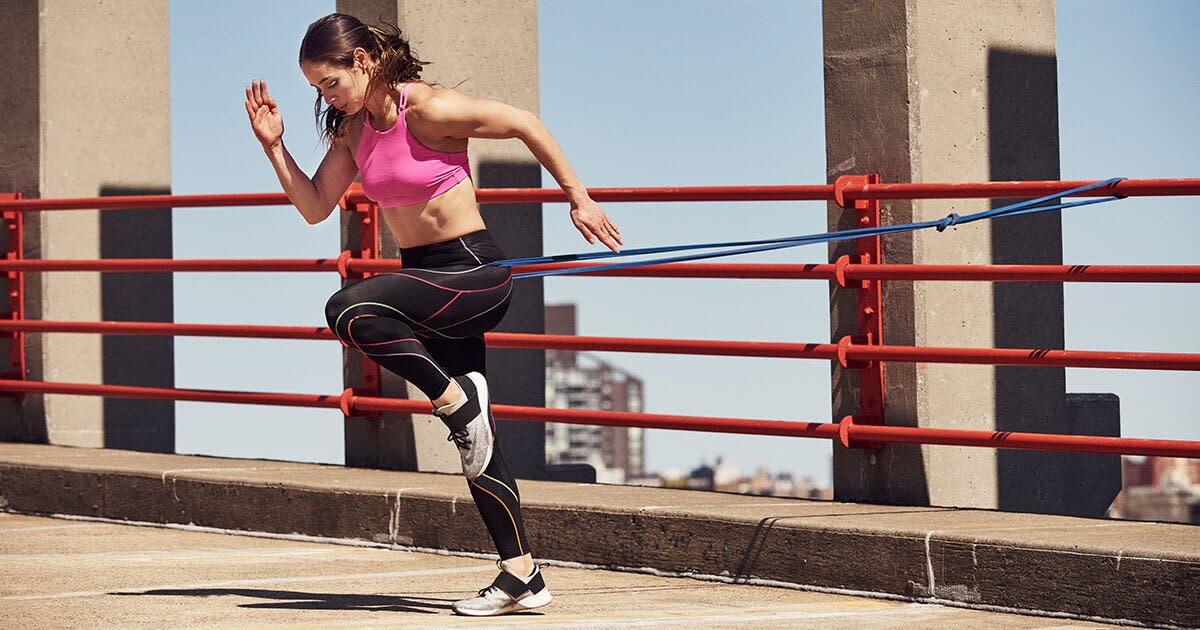The 5 Essential Cross-Training Workouts All Runners Need

Photo: James Farrell
Cross-training-you know it's de rigueur if you aim to fuel your running power, but the specifics can be a little fuzzy. So here's your goal: "You want to build up muscles that you wouldn't normally use in running and increase your aerobic capacity," says Harry Pino, Ph.D., an exercise physiologist at NYU Langone's Sports Performance Center. "That's what will ultimately make you faster and more efficient on the road or trails." The mistake that many runners make is cross-training without a clear direction, so they put in the gym time without making progress, he says. We cut to the chase and found the key workouts that will help you go longer and become stronger.

Strength Training
"Distance runners get used to activating only certain muscles when they run, so they're not using the full potential of all their muscles together," says Kyle Barnes, Ph.D., an exercise physiologist at Grand Valley State University in Michigan. "Resistance training forces you to contract or utilize more of your muscles." When female runners squeezed in two heavy resistance-training sessions a week for nine weeks-doing sets of both upper-body moves such as bench presses and lower-body moves like split squats-they improved their 5K time by 4.4 percent (that's like shaving 1 minute, 20 seconds off a 30-minute finish time), Barnes' research found. And since runners tend to be quad dominant, strength training is an opportunity to focus on the glutes. "The glutes are the largest muscle in the body, so they're actually one of the most important running muscles," Barnes says.
"If we can get those to fire and work properly, you'll easily see enhancements in performance." Moves like squats and deadlifts are great for hitting your glutes and hamstrings. Plus, instead of going for machines at the gym, Pino recommends sticking to free weights. This allows you to activate more of your core muscles and challenge your balance. (Here's a strength training routine made specifically for runners.)
Pilates
Having a strong core will help you avoid typical form pitfalls (like rotating your pelvis too much as you stride) that sap your efficiency, Pino says. That's where Pilates comes in. "Pilates addresses the entire core-not just the rectus abdominis but the deeper muscles," says Julie Erickson, a certified Pilates and yoga instructor in Boston. Moves like the double-leg stretch and the hundred are especially good at challenging the deepest ab muscles. Some Pilates exercises work the inner thighs too, which can be weak in runners, Erickson says: "Your inner thigh muscles support the knee, so strengthening them will protect you from injury and make quick changes in direction easier, like on rocky trails." Even just getting a playground ball and squeezing it between your thighs while you're watching Netflix can help, she says. (For a similar effect, try this barre workout for runners.)
Plyometric Training
Plyos, or explosive strength training that involves jumping, are key for helping you build speed, a recent study in the Journal of Strength and Conditioning Research found. When researchers had a group of runners continue with their usual training, add resistance and plyometric exercises, or add strength training, the runners in the plyo group reduced their 3K (just shy of 2 miles) times most-by 2 percent after 12 weeks. "This is significant for distance runners because it shows an improvement in their running economy," says study author Silvia Sedano Campo, Ph.D. That means by increasing your maximal strength through plyometric training, you can run faster without needing to burn extra fuel, she says. Focus on horizontal jumps like the standing long jump and forward bounding, or skipping. "These are more effective to improve running economy, because they're directly related to stride length," Sedano Campo says. Then follow each set of plyos with a quick sprint to ensure strength improvements are transferred to a real movement.
Yoga
Runners have a tendency to look down frequently, which rounds their shoulders forward and closes off the front of the body, but practicing yoga can open up those problem areas, Erickson says. "When you improve your posture and train yourself to look forward while running, it expands your chest so you can breathe better," she says. The increased oxygen to your muscles can in turn improve your efficiency. Warrior I and warrior II, which are done frequently in most yoga classes, are great chest openers. And that tightness you feel in your hamstrings and hip flexors? Many asanas address those areas, but Erickson particularly likes the seated forward bend and the crescent lunge. To give your hammies some extra attention. (Check out our 11 essential yoga poses for runners.)
Spinning
To up your cardio capacity without the stressful pounding, high-intensity cycling is the winning way to go, research in the European Journal of Sport Science shows. Triathletes who did six high-intensity interval cycling sessions (that included five-minute sprints) over three weeks improved their 5K run time by up to two minutes and increased their VO2 max by about 7 percent. An increased VO2 max means you'll be able to sustain exercise for longer periods-important if your goal is to finish a longer race like a marathon. "Endurance athletes can get stuck in training long mileage at low intensity, but short, intense bursts build the anaerobic system, which is also needed during endurance events," says study author Naroa Etxebarria, Ph.D., an exercise physiologist at the University of Canberra in Australia. Working your anaerobic system will help you stave off fatigue. And the benefit of doing your HIIT while cycling is that you spare your joints the stress of striking the ground with two to three times your body weight, as sprinting does.

